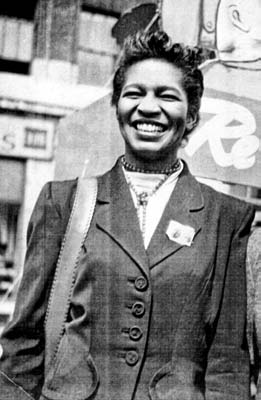This month’s Kickass Woman is Claudia Jones. Wielding a pen instead of a sword did not make this woman any less of a warrior, one who did battle in three countries in her short life and shared not only Black anger but also Black joy.

Born in 1915, Claudia Vera Cumberbatch was born in Trinidad and Tobago, which was, at the time, a colony of Britain (it is now the Republic of Trinidad and Tobago, consisting of several Caribbean islands). When she was seven years old her parents left for the United States in search of employment.
Claudia joined them when she was nine. She was radicalized by witnessing and experiencing racial and economic injustice in New York. Her mother, a garment worker, died a few years later and her father lost his job in the Great Depression. As a result of poor living conditions and poor nutrition, Claudia developed tuberculosis which left her with permanent heart disease.
Claudia graduated from high school and began her activism career with organizing protests regarding the Scottsboro case. She joined the Communist Party in 1936. She rose to a leadership position within the Communist Party of the United States of America, and was later jailed for her Communist beliefs in 1948. In 1955 she was deported and left for London.
The term “intersectionality” was not coined until 1989 by Kimberlé Crenshaw but Claudia was an early adopter of its principles. Her essay “An End to the Neglect of the Problems of the Negro Woman” in 1949 was a mission statement that expressed concepts Claudia would fight for all her life: that the fight for liberation must include gender and class as well as race:
A developing consciousness on the woman question today, therefore, must not fail to recognize that the Negro question in the United States is prior to, and not equal to, the woman question; that only to the extent that we fight all chauvinist expressions and actions as regards the Negro people and fight for the full equality of the Negro people, can women as a whole advance their struggle for equal rights.
For the progressive women’s movement, the Negro woman, who combines in her status the worker, the Negro, and the woman, is the vital link to this heightened political consciousness.
From the same essay:
No peace can be obtained if any women, especially those who are oppressed and impoverished, are left out of the conversation.
In London, Claudia quickly became a Communist Party leader and turned her attention to Caribbean immigrants. This was the era of the ‘Windrush Generation’ and immigrants struggled to access basic needs and rights. The Notting Hill Riots of 1959, where Black immigrants were attacked in their homes, further traumatized the Black community.

Claudia looked to art in the face of violence. In the words of British Vogue:
A firm believer that “a people’s art is the genesis of their freedom”, she utilised the opportunity to uplift the community by celebrating its culture and heritage with the launch of a special showcase for Afro-Caribbean talent. Originally dubbed Claudia’s Caribbean Carnival, the first event took place at St Pancras Town Hall on 30 January 1959 and was televised by the BBC. The following six years would see the annual celebration staged in local town halls and community centres, where people would get together for a comparatively low-key version of the street extravaganza we indulge in today.
For the first few years the carnival’s motto was “A people’s art is the genesis of their freedom.”
As time passed Claudia’s Carnival became one of the inspirations for and precursors of the outdoor Notting Hill Carnival. It is now the second largest carnival in the world.

Claudia’s impoverished youth and four imprisonments did terrible damage to her heart. She died of a heart attack at the age of 49, on Christmas Eve in 1964.
Her insistence that the rights of women, people in poverty, people of color, and immigrants all be upheld within the political Left, as well as without it, left a legacy of intersectionality that was ahead of its time.

Sources for more information:
